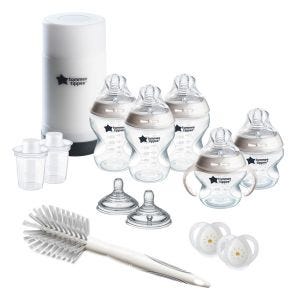
This is a demo store. No orders will be fulfilled.
Subscription orders can be cancelled at anytime. Free delivery on all subsequent subscription orders. Find out more about subscriptions.
They’re easy and fuss free
Your products are automatically sent to you
You save up to 10% when you sign up for a subscription
You can cancel at any time
When you're pregnant, you can collect colostrum by hand expressing, then use it to feed your newborn baby.
This guide is here to tell you everything you need to know about colostrum, including what it is, and how to collect, store and transport it.
Colostrum is the first breast milk your body makes. It's thick and sticky in consistency, and usually yellow, clear, or milky colored. It's high in calories, full of antibodies, and packed with stem cells. This supports your baby's immune system and development and can help you establish a good breastfeeding routine from birth and beyond.
Colostrum is highly concentrated and produced in small amounts. Even just a small portion of your colostrum will be beneficial nutritionally for your baby, as their stomach is only the size of a marble when they're born.
Antenatal hand expression of colostrum can help you feel more prepared for breastfeeding and means you have some nutrient-rich milk ready to give to your baby when they're born. It's a great step for anyone who is pregnant, but it's particularly recommended for those who:
It can also help if your baby's likely to experience issues with their blood sugar levels or may struggle to feed after birth because they:
The best time to start collecting colostrum is between 36 and 37 weeks of pregnancy.
Before you start expressing, you should make sure your hands are clean. You will need sterilized oral syringes and a larger sterilized container.
To collect your colostrum, follow these simple steps:
How much colostrum you collect in an expressing session can vary from just a few drops to a teaspoon full. Don't compare yourself to others and remember that every drop counts!
Remember that colostrum is a very concentrated food and newborn babies only need a small amount per feed - about a teaspoonful.
Once collected, your colostrum syringes can be dated, labelled, and stored in your freezer, ready to give to your baby once they arrive.
You can store your expressed colostrum syringes at the back of the refrigerator between 35��F and 39��F for up to 24 hours before you freeze it. It'll last for up to 24 hours if kept in a cool bag with ice packs - when you're transporting to hospital, for example.
When you label your syringes, be sure to include:
To bring your expressed colostrum into the hospital when you have your baby, you'll need:
When you're going to the hospital to give birth, you can place some of your frozen colostrum syringes in a re-sealable bag and put it inside a cool bag between a bag of crushed ice or some ice blocks.
Tell your midwife that you have colostrum with you when you arrive at the hospital. They will label it and store it in the fridge or freezer at the hospital for you.
Once they're born, some newborns struggle to breastfeed at first, and others are unable to maintain their blood sugar levels. In these situations, your expressed colostrum is the perfect first food for your baby.
Before you feed your baby, the syringe needs to be brought to room temperature. To do this, you can place the bag with the syringe fully into warm water. Your midwife will demonstrate how to use a small cup or syringe to feed it to your baby.
Having a small feed with colostrum helps give your newborn a boost in energy and blood sugar levels. It can also help to encourage them to breastfeed.
Hannah told us that "during the last few weeks of pregnancy, [she] was diligent in expressing colostrum ready for [her] boys planned arrival at 37 weeks." And Natasha said that she only "started having more knowledge of terminology like latching, colostrum and all the feeding terms, when [she] had [her] second child".
You should only use your hands for expressing during pregnancy and it's recommended that you don't use a breast pump to express breastmilk until after your baby has been born.
Before you begin to hand express and collect colostrum, be sure to speak to your midwife or a healthcare professional first. They can help make sure it's right for you and your baby and can answer any questions you have.
Follow these simple steps to collect colostrum with a syringe:
It's important to note that colostrum harvesting produces oxytocin (the hormone that produces contractions in labor). On rare occasions, it can also stimulate Braxton Hicks contractions. Don't worry though, it's very unlikely that collecting your colostrum will trigger labor.
If you experience mild labor contractions or cramps comparable to period pain, it's recommended that you stop collecting colostrum. Take some time to rest before trying again. If contractions continue while you're collecting colostrum, you should seek medical advice and wait until you're closer to your due date before you resume.
Gentle massage, applying a warm compress, or expressing after a warm bath or shower can encourage your colostrum to flow.